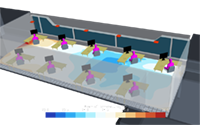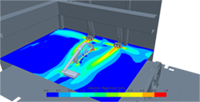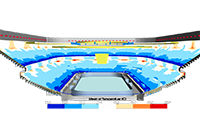SERVICES FOR SIMULATION OF INDOOR ENVIRONMENT AND THERMAL COMFORT
NUMERICAL SIMULATION (CFD-MODELING) OF AIRFLOW
(CFD-modeling)

This is a numerical solution of differential equations aimed at determining the distribution of temperatures, velocities, relative humidity, harmful impurities, carbon dioxide, etc., as well as calculating the wind loads and other building loads.
Simulation of Indoor Environment for Public Buildings
more

— Offices
— Hotels
— Shops
— Atriums
— Conference halls
— Theaters
— Restaurants
— Shopping malls
— Exhibition halls
The more complex the facility (large space and height of the premises, irregular layout of heat gain sources, high concentration of people, large glass areas, etc.), the less certainty that engineering techniques will be instrumental in organizing an intelligent air distribution layout of the premises. As a consequence, cold air drafts at workplaces, spread of odors throughout the restaurant spaces, stuffiness in shopping malls, condensation build-up on the translucent roof of the atrium in winter, superheated upper section of the atrium in summer, noticeable temperature differentials in different places in the auditorium, etc.
Simulation of indoor environment of premises in public buildings includes the following:
1. Analysis and simulation for HVAC design support. The result of numerical simulation of thermal comfort is presented in the form of distribution of temperature, air velocity, CO2 concentration, humidity in the premises.
2. Development of adjustment of HVAC design support to provide the required indoor environment parameter values in the premises.
HVAC System Simulation for Industrial Premises
more

Utmost accuracy and responsibility is required to organize air change in industrial premises.
Failure to meet the quality requirements for air environment even in local areas of the building may result in both personnel morbidity and non-compliance with the industrial process requirements.
Numerical simulation (CFD-modeling) of airflow will be instrumental in:
— Considering the irregular arrangement of sources of heat and health hazards and their effect on temperature and airflows in the premises
— Considering the effect of the radiation heat exchange of heated surfaces on the temperature of air in the premises, convection currents created in the shops.
HVAC system simulation for industrial premises includes the following:
1. Simulation for HVAC design support in terms of air distribution to make sure that the indoor environment parameters arising in the facility premises meet the required values.
2. Development of adjustment of HVAC design support to ensure the required indoor environment parameter values in the premises.
3. In-depth analysis of indoor environment parameters near the industrial process, optimization in terms of air distribution, humidification, heating, carryover of occupational hazards
Simulation of indoor environment for Sports Facilities
more

— Swimming pools
— Ice arenas
— Gyms, sports and recreation centers
Sports facilities are typically classified as unique buildings. Without the use of methods of simulation of airflow, the analysis and simulation for HVAC design support alone does not guarantee the compliance with the thermal comfort and process requirements in the premises.
This is due to the fact that:
— In spacious premises, free-convection currents begin to exert a noticeable influence on the formation and distribution of supply air jets
— Spacious premises feature significant temperature stratification
— Sports facilities are complicated by such processes as water surface evaporation and ice sublimation
— Sports facilities are characterized by significant heat produced by spectators and lighting equipment
— Sports facilities are noticeable for two process areas with different supported indoor environment parameter values: spectator and athlete areas
Sports facilities simulation includes the following:
1. Analysis and simulation for HVAC design support in terms of air distribution to ensure that the indoor environment parameters arising in the facility premises meet the design temperature, velocity and humidity values. Simulation of airflow is carried out using methods of three-dimensional numerical simulation (CFD-modeling).
2. Detection of an area with deviating average and local values of temperature, concentration of harmful substances, humidity, velocity in the facility premises.
3. Development of adjustment of the initial HVAC design support in the event of detection of areas with the indoor environment parameter deviating from the design value.
Текст…
